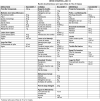Nutritional quality of foods and beverages on child-care centre menus in Mexico
- PMID: 23036360
- PMCID: PMC3867121
- DOI: 10.1017/S1368980012004387
Nutritional quality of foods and beverages on child-care centre menus in Mexico
Abstract
Objective: The purpose of the present study was to assess the nutritional quality of foods and beverages listed on menus serving children in government-sponsored child-care centres throughout Mexico.
Design: For this cross-sectional menu assessment, we compared (i) food groups and portion sizes of foods and beverages on the menus with MyPlate recommendations and (ii) macronutrients, sugar and fibre with Daily Reference Intake standards.
Setting: Menus reflected foods and beverages served to children attending one of 142 government-sponsored child-care centres throughout Mexico.
Subjects: There were fifty-four distinct menus for children aged 4–6 months, 7–9 months, 10–12 months, 13–23 months, 24–47 months and 48–72 months.
Results: Menus included a variety of foods meeting minimum MyPlate recommendations for each food category except whole grains for children aged 48–72 months. Menus listed excessive amounts of high-energy beverages, including full-fat milk, fruit juice and sugar-sweetened beverages for children of all ages. The mean daily energy content of menu items yielded an average of 2?76 MJ for infants, 4.77 MJ for children aged 13–23 months, 5.36 MJ for children aged 24–47 months and 5.87 MJ for children aged 48–72 months. Foods and beverages on menus provided sufficient grams of carbohydrate and fat, but excessive protein.
Conclusions: Menus provided a variety of foods but excessive energy. Whole grains were limited, and high-energy beverages were prevalent. Both may be appropriate targets for nutrition intervention. Future studies should move beyond menus and assess what children actually consume in child care.
Figures
Similar articles
-
Comparison of menus to actual foods and beverages served in North Carolina child-care centers.J Am Diet Assoc. 2010 Dec;110(12):1890-5. doi: 10.1016/j.jada.2010.09.012. J Am Diet Assoc. 2010. PMID: 21111096 Free PMC article.
-
Assessment of mealtime environments and nutrition practices in child care centers in Georgia.Child Obes. 2013 Oct;9(5):437-45. doi: 10.1089/chi.2013.0018. Epub 2013 Sep 19. Child Obes. 2013. PMID: 24050433
-
Comparison of planned menus and centre characteristics with foods and beverages served in New York City child-care centres.Public Health Nutr. 2016 Oct;19(15):2752-9. doi: 10.1017/S1368980016000720. Epub 2016 Jun 10. Public Health Nutr. 2016. PMID: 27280341 Free PMC article.
-
Implementation of Minimum Nutrition Standards and Best Practices in Childcare Centers.J Acad Nutr Diet. 2021 Dec;121(12):2454-2463. doi: 10.1016/j.jand.2021.05.019. Epub 2021 Jun 29. J Acad Nutr Diet. 2021. PMID: 34215563
-
Indian Academy of Pediatrics Guidelines on the Fast and Junk Foods, Sugar Sweetened Beverages, Fruit Juices, and Energy Drinks.Indian Pediatr. 2019 Oct 15;56(10):849-863. Epub 2019 Aug 10. Indian Pediatr. 2019. PMID: 31441436 Review.
Cited by
-
Nutritional Intervention to Improve the Quality of Lunchboxes Among Mexican School Children.J Community Health. 2016 Dec;41(6):1217-1222. doi: 10.1007/s10900-016-0207-5. J Community Health. 2016. PMID: 27240816 Clinical Trial.
-
Chronic sleep curtailment and adiposity.Pediatrics. 2014 Jun;133(6):1013-22. doi: 10.1542/peds.2013-3065. Pediatrics. 2014. PMID: 24843068 Free PMC article.
-
Interventions to prevent obesity in Latinx children birth to 6 years globally: a systematic review.Public Health Nutr. 2023 Nov;26(11):2498-2513. doi: 10.1017/S1368980023001283. Epub 2023 Aug 25. Public Health Nutr. 2023. PMID: 37622420 Free PMC article.
-
Evaluation of the impact of the Healthy Start/Départ Santé intervention on improving menu planning practices and improving the congruence between planned menus and actual food served in Saskatchewan childcare centres.Prev Med Rep. 2021 May 25;23:101403. doi: 10.1016/j.pmedr.2021.101403. eCollection 2021 Sep. Prev Med Rep. 2021. PMID: 34136337 Free PMC article.
-
Do Preschools Offer Healthy Beverages to Children? A Nationwide Study in Poland.Nutrients. 2017 Oct 26;9(11):1167. doi: 10.3390/nu9111167. Nutrients. 2017. PMID: 29072604 Free PMC article.
References
-
- Romieu I, Hernandez-Avila M, Rivera J et al. (1997) Dietary studies in countries experiencing a health transition: Mexico and Central America. Am J Clin Nutr 65, 4 Suppl., 1159S–1165S. - PubMed
-
- Rivera JA, Barquera S, González-Cossío T et al. (2004) Nutrition transition in Mexico and in other Latin American countries. Nutr Rev 62, 7 Pt 2, S149–S157. - PubMed
-
- Fernald LC & Neufeld LM (2006) Overweight with concurrent stunting in very young children from rural Mexico: prevalence and associated factors. Eur J Clin Nutr 61, 623–632. - PubMed
-
- Rivera JA, Monterrubio EA, Gonzalez-Cossio T et al. (2003) Nutritional status of indigenous children younger than five years of age in Mexico: results of a national probabilistic survey. Salud Publica Mex 45, Suppl. 4, S466–S476. - PubMed
-
- Rivera JA & Sepulveda Amor J (2003) Conclusions from the Mexican National Nutrition Survey 1999: translating results into nutrition policy. Salud Publica Mex 45, Suppl. 4, S565–S575. - PubMed
Publication types
MeSH terms
Grants and funding
LinkOut - more resources
Full Text Sources


